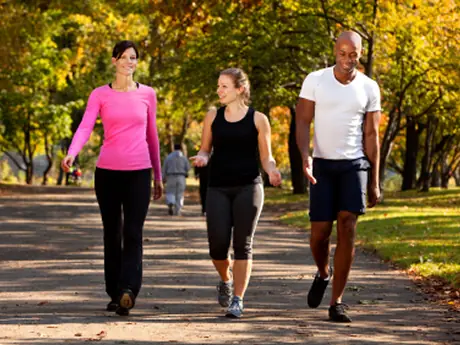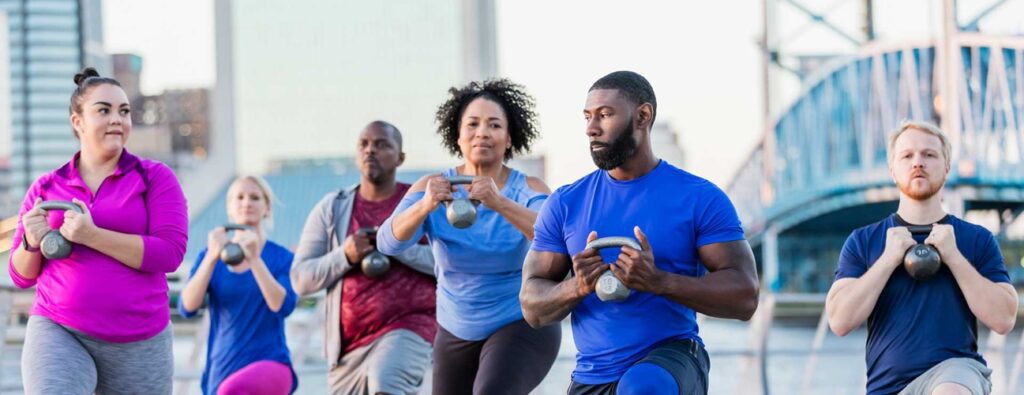
Adults are supposed to engage in 150+ minutes of moderate to vigorous exercise each week! How are you getting your in?! Below are some examples and ways to tell what intensity you are exercising at.
Light Intensity Exercise
Light exercise activities require less effort and should be a comfortable pace for you. Most people do not usually break a sweat, and your target rate is 40% to 50% of your maximum heart rate. You should be able to sing while doing light intensity exercises.
Types of light intensity exercises:

- Walking slowly
- Bicycling at less than 5 mph
- Stretching Sitting
- Light weight training
- Dancing slowly
- Leisure sports (table tennis, playing catch)
- Floating
- Boating
- Fishing
- Golf—using cart Light yard/housework
- light housework such as cooking, dusting, ironing, folding laundry, washing dishes, and putting away groceries.
Moderate Intensity Exercise
Moderate exercise activities involve quick breathing; however, no breathlessness and light sweat are produced. According to The American Heart Association, the recommended target heart rate is 50% to 70% of your maximum heart rate. This can be determined by your ability to talk but not sing the words of your favorite song during the workout.
Types of moderate intensity exercises:
- Walking downstairs or down a hill
- Bicycling and stationary bicycling
- Aerobic dancing—high impact
- Water aerobics
- Yoga
- Gymnastics
- General home exercises – getting up and down from the floor
- Jumping on a trampoline
- Ballroom dancing, Line dancing, Square dancing, Folk dancing, Modern dancing, Disco, and Ballet
- Golf, wheeling, or carrying clubs
- Softball—fast pitch or slow pitch
- Basketball—shooting baskets
- Coaching children’s or adults’ sports

Vigorous Intensity Exercise
Vigorous activities produce hard and fast breathing. You may also develop a sweat after a few minutes of activity. According to The American Heart Association, the recommended target heart rate is 70% to 85% of your maximum heart rate. To test the intensity of your activity at this level, you should not be able to say more than a few words without pausing for a breath.
Types of Vigorous intensity exercises
- Racewalking and aerobic walking—5 mph or faster
- Jogging or running
- Walking and climbing briskly up a hill
- Backpacking
- Mountain climbing, rock climbing
- Roller skating or in-line skating at a brisk pace
- Bicycling more than 10 mph or bicycling on steep uphill terrain
- Stationary bicycling—using vigorous effort
- Aerobic dancing—high impact Step aerobics
- Water jogging
- Teaching an aerobic dance class
- Karate, judo, tae kwon do, jujitsu
- Jumping rope
- Performing jumping jacks
- Circuit weight training
- Boxing—in the ring, sparring Wrestling—competitive
- Professional ballroom dancing, Square dancing, Folk dancing—energetically
- Tennis—singles
- Most competitive sports (Football game, Basketball game, Soccer, Rugby, rollerblade hockey, Lacrosse)
- Beach volleyball—on a sand court
- Handball—general or team
- Racquetball
- Squash
- Downhill skiing—racing or with vigorous effort
- Ice-skating—fast pace or speedskating
- Playing ice hockey
- Swimming—steady paced laps
- Synchronized swimming
- Jumping rope
- Performing jumping jacks
- Gardening and yard work: heavy or rapid shoveling (more than 10 lbs per minute), digging ditches, or carrying heavy loads
- Pushing a nonmotorized lawn mower
References
https://www.cdc.gov/nccdphp/dnpa/physical/pdf/pa_intensity_table_2_1.pdf
https://www.heart.org/en/healthy-living/fitness/fitness-basics/target-heart-rates
https://www.mayoclinic.org/healthy-lifestyle/fitness/in-depth/exercise-intensity/art-20046887
Author: Efua Arthur
Want more? Check out other articles on our ¡Viva Bien! Blog:
